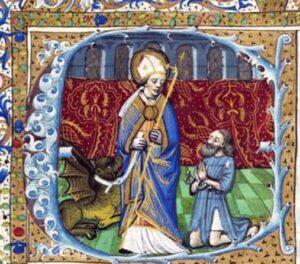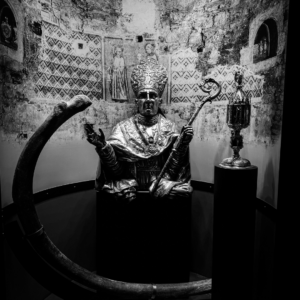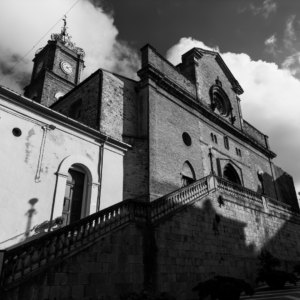 Saint Leucio is a figure revered in many places in Italy, with a cult that has spread widely through legends and folk traditions. The celebration of Saint Leucio in Atessa on January 11 is particularly significant. According to legend, Saint Leucio freed the town of Atessa from a dragon that haunted the Sangro Valley. Legend has it that the saint killed a fierce dragon that was claiming victims and preventing the inhabitants of two villages, Ate and Tixa, from dating and reuniting. The slaying of the much-feared monster led to the reunification of the communities settled on the two hills in the village of Atessa with a collective celebration rite, thanks in part to the healings that the therapeutic power of the dragon’s blood dispensed against joint pain and kidney affections. The saint donated a rib from the ferocious animal to the people as an eternal memorial of the miraculous intervention and asked the people to build him, as an act of devotion, a sacred temple on the remains of the cave inhabited by the dragon.
Saint Leucio is a figure revered in many places in Italy, with a cult that has spread widely through legends and folk traditions. The celebration of Saint Leucio in Atessa on January 11 is particularly significant. According to legend, Saint Leucio freed the town of Atessa from a dragon that haunted the Sangro Valley. Legend has it that the saint killed a fierce dragon that was claiming victims and preventing the inhabitants of two villages, Ate and Tixa, from dating and reuniting. The slaying of the much-feared monster led to the reunification of the communities settled on the two hills in the village of Atessa with a collective celebration rite, thanks in part to the healings that the therapeutic power of the dragon’s blood dispensed against joint pain and kidney affections. The saint donated a rib from the ferocious animal to the people as an eternal memorial of the miraculous intervention and asked the people to build him, as an act of devotion, a sacred temple on the remains of the cave inhabited by the dragon.

The dragon’s rib, about two meters long and venerated as a relic in Atessa Cathedral, is a central element of this legend. Before being placed in a glass case in the Treasure Room of San Leucio, the rib hung from one of the church’s ceiling beams. Hypotheses about its real origins vary: some suggest it may have come from a large charnel house dating back to the time of Pyrrhus or Hannibal’s passage with elephants through Abruzzo, but more likely it is a bone of Misticeto, a cetacean of the suborder of the baleen whales, dating back millions of years, when the Sangro Valley was submerged by the sea up to the slopes of Mount Pallano and the Maiella. In addition to the rib and the silver bust of the saint, the Treasure of San Leucio holds a masterpiece of Abruzzo goldsmith art: themonstrance made in silver and enamels by Nicola da Guardiagrele in 1418 specifically for the church in Atessa.
But how did his cult come to Abruzzo?
The cult of St. Leucio originated in Brindisi, where the saint first held the office of bishop and where he died between the fourth and fifth centuries. His veneration quickly spread to the cities of the Duchy of Benevento, and his relics were moved to Trani around 680, after the conquest and sacking of Brindisi by the Lombards. In Trani, the cult took root, although today it is almost forgotten, surviving only in the hypogeum dedicated to the saint under the magnificent Cathedral.

From Apulia, the cult spread through the transhumance routes to Abruzzo and Lazio. Shepherds brought their flocks along these routes, encouraging the spread of veneration for St. Leucio to the Apennine regions. In particular, at Rocca di Mezzo on the Altopiano delle Rocche plateau and at Villavallelonga in Marsica, where the cult dates back at least to the year 1000, consolidating with the construction of a church dedicated to the saint. The veneration of the shepherds was such that it prompted the archbishop of Trani to donate a relic to them. Thus it was that in 1778 a finger bone of St. Leucio left Trani in the custody of shepherds returning to their native place after the winter transhumance.
The cult of Saint Leucio is still alive among the communities of Marsica, with annual celebrations involving both residents and emigrants, particularly in July and August. Transhumance, once a common practice, played a crucial role in keeping the tradition alive, with shepherds taking part in the celebrations, between Trani and the shrines dedicated to the saint along the sheep-tracks. So much so that in Rocca di Mezzo, among the shepherds, the saying “chi a Ssa’ Levece n’era revenute u z’era morte u z’era perdute” circulated: “those who had not returned to San Leucio were either dead or lost.”








